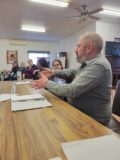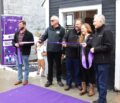Headline News
Gatley gives Airy Pedestrian Bridge cost benefit analysis
September 29, 2021
By Mike Riley
Local Journalism Initiative Reporter
At their council meeting on Sept. 1, South Algonquin Township council heard a cost benefit analysis of the restoration of the Airy Trestle, provided by Dave Gatley, the public works superintendent. Providing them with three options and corresponding costs to the project, he recommended going with the second option, which would cost the township $139,573.02, which would be taken from reserves. After some discussion on the benefits and drawbacks of each option, council voted to go with option two for the Airy Trestle restoration.
The Airy Trestle restoration was last talked about at the South Algonquin Human Resources/Administration/Public Relations committee meeting on Aug. 25. While the rehabilitation costs were larger than they had originally anticipated and they would have to use a percentage of the township’s reserves to cover the overlay, the committee decided to recommend going ahead with the project to restore the trestle, pending another look at wood prices from the local lumber mills and a cost benefit analysis to look at the value factor that would be involved with going with a better wood than hemlock that would potentially be longer lasting.
The Airy Trestle was last renovated back in the 1990s, and it used to be a train track. Councillor Bongo Bongo said it is beloved by the entire community and he believes that it makes Whitney truly unique.
Gatley came to council on Sept. 1 with more information about the wood prices and a cost benefit analysis of the rehabilitation of the trestle.
“So, I had some discussions with the engineer [Chris Bent from Jewell Engineering] about the life cycle of Douglas fir compared to hemlock. I wasn’t able to find any data on pressure treated hemlock or Douglas fir. The Douglas fir is classified as moderately durable while the hemlock is classified as slightly durable,” he says.
For the life cycle of the Douglas fir, he found it was 60 to 100 years, and while he found no information on hemlock, judging from the deterioration of the hemlock used on the trestle originally, he estimated it would have a lifespan of around 30 years. As Councillor Joe Florent pointed out later on in the meeting, when the hemlock was pressure treated it could have a longer lifespan. Gatley conceded this but had no data on how much longer the pressure treating would make the hemlock last.
There were three options presented to council for the trestle rehabilitation; option one would have Douglas fir for the structural members and western cedar for the railings, option two would have Douglas fir for the structural members and spruce for the railings, and option three would use hemlock donated by McCrae Lumber in the township instead of the Douglas fir. This included timber frame cribs on both sides of the approaches and shoreline rock protection that the engineers felt was necessary. The third option would provide savings on the project, although the township would need to get the hemlock pressure treated for a cost of $2,000.
Overall, the total cost of the job after the HST rebates would be $243,389.03 for option one, $239,573.02 for option two, and $192,980.08 for option three. Factoring in the $100,000 grant the township procured [from the Investing in Canada Infrastructure Program: COVID-19 Resilience Infrastructure stream], that would leave the township covering the balance of the cost. This would necessitate taking money from the reserves; 5.8 per cent, 5.6 per cent and 3.7 per cent for options one, two and three respectively.
As for the cost benefit analysis he had compiled, Gatley said that with a 60-year lifespan for options one and two, the annual depreciation expense would be $4,056.48 and $3992.88 respectively and the trestle would have to be replaced in 2081. Option three had a 30-year lifespan with an annual depreciation expense of $6,432.67 and the structure would need to be redone in 2051. Therefore, he recommended going with option two as the best “bang for the buck” and the best value for the taxpayer over time.
There was a 20 per cent contingency fee added to the costs in option three, and Gatley explained why.
“I had a discussion with the engineer about the 20 per cent contingency and he felt that the tender did not need contingencies under options one and two, that it was a complete bid with all items covered. Option three reflects that during construction if they decided we needed to build those timber cribs or the approaches because or erosion and go ahead with the rock protection that that amount [$31,607] would cover that. And also, maybe some unforeseen delivery or production costs of getting the hemlock to the pressure treater and back to us. So, I was trying to make it more of an apples-to-apples comparison. That’s where that 20 per cent came from,” he says.
Gatley said he’d be checking with the company that will be doing the work to see if they’re still willing and able to complete the job this fall and he said he’d get back to council with an answer. In answer to a query from Councillor Richard Shalla about securing the trestle, which is falling apart, should it not be restored this year, for public safety, Gatley said they would “cross that bridge when they came to it.”
Dumas invited council to discuss the pros and cons of the three options presented to them, which they did in a fulsome manner.
Councillor Dave Harper brought up again how he firmly believed that Algonquin Park should shoulder some of the financial responsibility for the trestle as they derive as much if not more benefit from it than South Algonquin does. Bongo refuted that assertion at the Aug. 25 HR/Admin/PR meeting by saying that since South Algonquin owned the infrastructure, they are responsible for the maintenance and negotiating with Ontario Parks would only serve to delay an already overdue project.
Harper also had a question about how the 5.6 per cent taken from the reserve to fund the trestle rehabilitation would reflect on future township budgets if at all. Bryan Martin, the CAO/clerk-treasurer, said that it will be factored into the reserves based on reserve allocations that council feels is adequate based on recent policies that they’ve established.
“It’ll be part of our total planning process. So anytime we draw down our reserves for any purpose we need to replenish them. I think we would just plan that those reserve transfers would be refunded over a period of time back into the reserve in order to minimize the financial impact on an annual basis,” he says.
Ultimately, council voted to go with option two, which Dumas acknowledged was the choice of council going forward on the trestle rehabilitation project. She thanked Gatley for his presentation.
“It’s great. It’s going to enhance many aspects of life in South Algonquin to get our Airy Trestle back up to prime condition!”


















